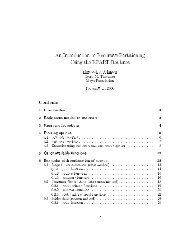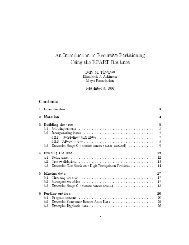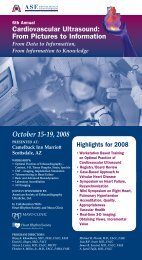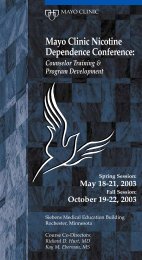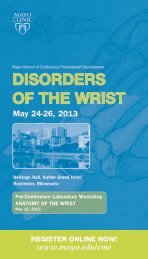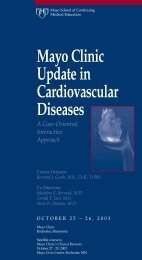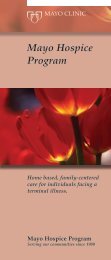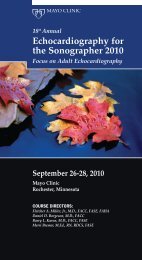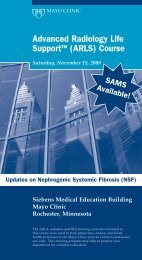Winter 2008-2009 - Mayo Clinic
Winter 2008-2009 - Mayo Clinic
Winter 2008-2009 - Mayo Clinic
Create successful ePaper yourself
Turn your PDF publications into a flip-book with our unique Google optimized e-Paper software.
The Tobacco-Free Living center’s primary goal is to<br />
support those seeking treatment for tobacco dependence<br />
by providing:<br />
• Research-based information about the biological basis<br />
for tobacco dependence and why some people have more<br />
difficulty quitting tobacco than others<br />
• Personal stories from patients who became tobacco-free<br />
• Information about the most effective treatment methods<br />
• Easy access to treatment<br />
All information is presented nonjudgmentally. “People<br />
who use tobacco don’t want lectures,” says Tom Gauvin, a<br />
counselor in the Nicotine Dependence Center. “They have<br />
already heard about the dangers of tobacco, and they may<br />
feel ashamed about their lack of success in quitting. By<br />
using the disease model to help patients understand tobacco<br />
dependence, we alleviate the guilt and shame and increase<br />
the chances of success for these individuals.<br />
“The Center for Tobacco-Free Living is intended to be a<br />
safe environment in which tobacco users can be supported<br />
and become engaged in the possibility of treatment. The<br />
straightforward, educational, positive tone is designed to<br />
excite and encourage people in their fight against tobacco.<br />
Ideally, of course, the center is an accessible clinical entry<br />
point for treatment in our Nicotine Dependence Center,<br />
but we want people to seek effective treatment anywhere.”<br />
Sheila Stevens, coordinator of education programs<br />
at the Nicotine Dependence Center, says that tobacco<br />
dependence treatment is underutilized. “More than<br />
40 million people in the United States smoke,” she says.<br />
“Most want to stop but, without treatment, only 3 percent to<br />
Grand opening: (from left to right) Glenn Forbes, M.D., CEO of <strong>Mayo</strong><br />
<strong>Clinic</strong> in Rochester; Andrew Limper, M.D., chair of the Department of<br />
Pulmonary and Critical Care Medicine; Richard Hurt, M.D., director<br />
of the Nicotine Dependence Center; and Denis Cortese, M.D.,<br />
president and CEO of <strong>Mayo</strong> <strong>Clinic</strong>, opened the Center for Tobacco-<br />
Free Living on Nov. 20, <strong>2008</strong> — the date of the American Cancer<br />
Society’s 33rd annual Great American Smokeout.<br />
5 percent of quit attempts are successful. Many people don’t<br />
understand that treatment greatly increases their chances of<br />
successfully quitting. If someone has diabetes, a combination<br />
of education and medication helps them manage their illness.<br />
If the first effort does not succeed, medication is changed,<br />
more counseling is provided and the health care team keeps<br />
working with the patient. That doesn’t often happen with<br />
smoking. Patients get lectured, and their willpower is<br />
questioned. Our counselors work hard to develop effective<br />
partnerships with patients without lecturing or blaming.“<br />
The Nicotine Dependence Center provides outpatient,<br />
residential and hospital services. Many patients in the residential<br />
program have tried other types of treatment without<br />
success. <strong>Mayo</strong>’s residential program has a 52 percent success<br />
rate for one year after treatment. Among outpatients, the<br />
The Anatomy of Addiction: This display in the Center for Tobacco-Free Living shows how addiction to nicotine occurs.<br />
Cigarettes rapidly deliver a large amount a highly addictive substance, which causes changes in the brain. These changes<br />
cause craving and withdrawal.<br />
www.mayo.edu/alumni | 11



